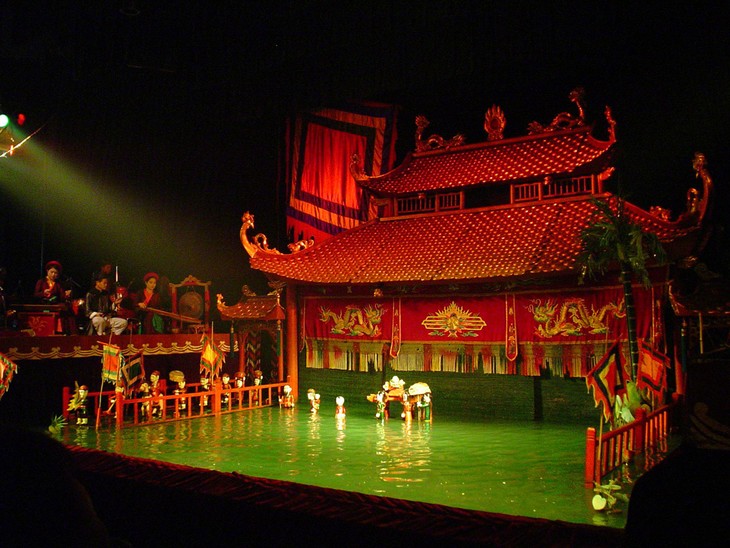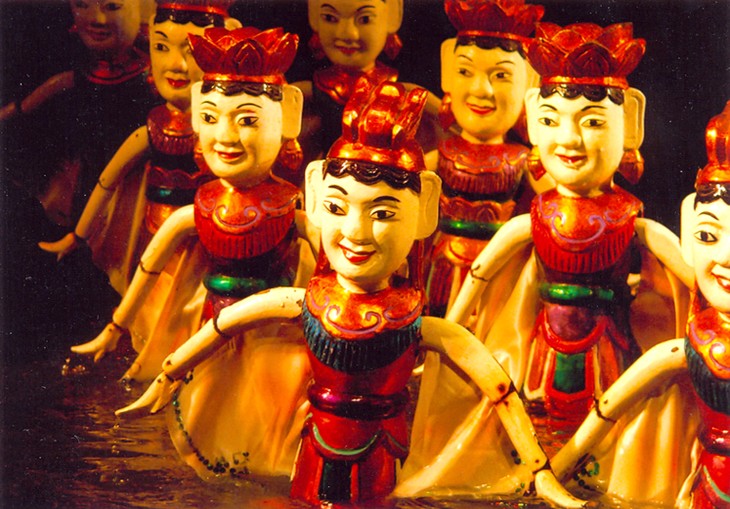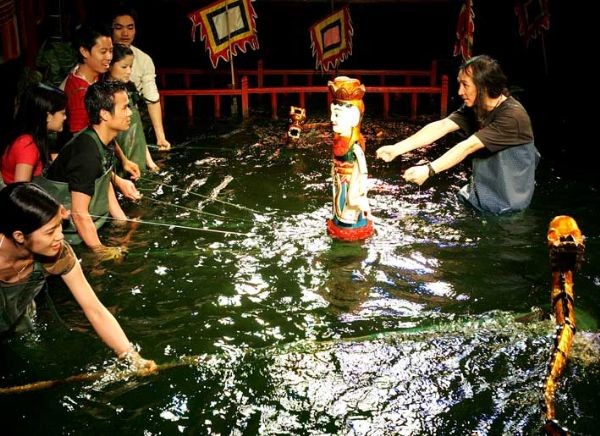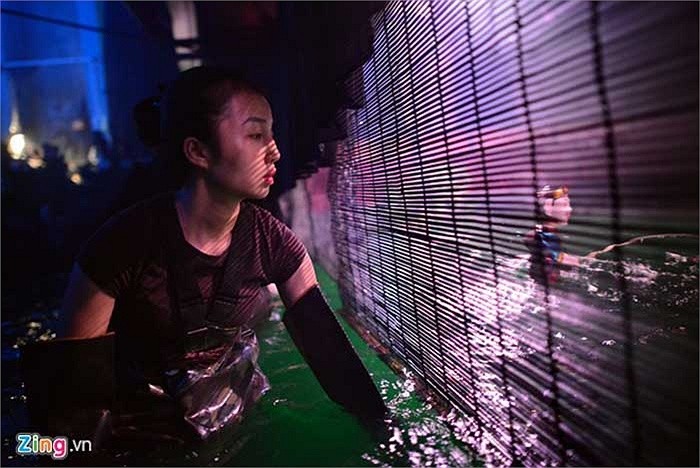(VOVworld) - Vietnamese water puppetry is a unique folk art, believed to be more than 1000 years old. A guide book says “Not watching a performance of water puppetry means not visiting Vietnam yet.” A water puppetry performance provides great fun and excitement for their audiences. Puppeteers cleverly manipulate wooden puppets on a special stage covered in water. In today’s show, let’s take a closer look at the making of water puppets and discover how they are controlled. VOV’s Ha Ngan has the story.
A Vietnamese water puppetry show means puppets performing on a shimmering water stage accompanied by music and singing. From the beginning to the end, audiences can only see the puppets and a small folk orchestra that performs live, not the puppeteers stand behind a curtained backdrop in a waist-deep pool. Nguyễn Hoàng Tuấn, Director of Thang Long Water Puppetry Theater, said the themes of the show are simple and familiar to Vietnamese people. “Water puppet plays avoid complicated themes and emotions. They focus on the daily life of farmers, as they work in the paddy fields, herd ducks, catch frogs, and race boats. They also feature common aspects of Vietnamese spiritual life, for example, illustrating the trance ritual, the dances of the dragon, lion, phoenix, and the fairy.”

Vietnamese water puppetry's stage (Photo: hanoicitybreaks) |
Since its traditional content revolves around the daily life of Vietnamese farmers and popular spiritual elements, the characters can be a cheerful husband and wife trying to protect their ducks from a cunning fox, or 2 dragons playing ball, spouting fire and water. They can also be dancers performing trance rituals with candles in their hands, hoping for the Mother Goddess to dispel the darkness and enlighten people’s minds. The puppet’s designs are strongly influenced by Vietnamese temple art, so they are carved and colored with the same aesthetic features characteristics of the characterized for statues of human and mascots in Buddhist temples.
 |
| Fairy's dance (Photo by: thanglongwaterpuppet) |
All puppets are made of fig wood. Chu Luong, Vice-Director of Thang Long Water Puppetry Theater and an experienced puppet designer, said that it is the best material for making the puppets. “Fig wood was considered useless because people couldn’t use it for cooking or furniture. It cannot be used for burning or making wooden equipment. Perhaps that was why Vietnamese people used it to practice carving things like puppets in their free time. People came to find out that the fig wood goes along well with water. It is the most endurable and suitable material for making water puppets.”
After being carved, the puppets are painted with lacquer. This process includes 5 main stages. Chu Lượng elaborated: “Firstly, the cracks on the puppets are filled with lacquer. Then the artist covers them with nets for protection. After that, the mixture of Vietnamese lacquer and alluvium from the Red River will be applied to the puppets. This stage is similar to plastering, which gives the puppets a water-proof surface. Next, the craftsmen will polish their surface. Finally, the puppets will be lacquered all in black and dried before being painted in other colors to form their faces, figures, and clothes.”
Vietnamese water puppets are manipulated by 2 main systems: rods and strings, under water. Every puppet needs them, though the specific device for each puppet may differ. Quốc Khanh, a puppeteer of Thang Long Water Puppetry Theater explains: “The first is a string mechanism. The puppet is controlled via a strong thin string attached inside, running through loops on the side of the rod to reach the hand of the puppeteers. For the second mechanism, the puppet’s base directly attaches to a rod accompanied with a paddle. The paddle will rotate when the base moves, making the puppet spin around, or in a certain direction, depending on whether a rudder is installed. It is more complicated to control water puppets by string than by rod.”
 |
| Water puppeteers manipulate the puppets by string and rod (Photo by: Clivehicksjenkin) |
A puppet can weigh up to 15 kg. So it requires strenuous efforts to control it, not to mention performing in a lively and beautiful manner. Quốc Khanh shared his experiences in performing the lion and phoenix dances: “The works on the lion and phoenix dances are the most energy-consuming. Though the puppets only need to be controlled by rods, it requires diligent practice and skill. Puppeteers should make sure that the puppet’s movements match the up-tempo music and vividly resemble the lion and phoenix in reality.”
 |
| Water puppeteer controlS the puppets behind the curtain (Photo by: Zing) |
Folk music is played at traditional puppet shows. Small orchestras of about 7 people perform live. Audiences can see the artists singing beautiful Vietnamese folk songs, however, in some parts, it is the puppeteer behind the curtain who sings or says lines at the same time. Quốc Khanh is one of them. “In the scene of farmers herding ducks, the puppeteer not only controls the puppet, but also reads lines and sings for the puppet. The character is similar to that of Chèo, the popular theater, so the artist must also know what it is like. I think it’s a challenge for new puppeteers when they have to fulfill multiple tasks simultaneously.”
You are listening to VOV’s Sunday show, our biggest show of the week. Now let’s enjoy the music for water puppet’s scene called ‘Farmers herding ducks’
 |
Vietnamese water puppetry's scene 'Farmer herding ducks' (Photo by: Amazingvietnam)
|
Today, the water puppets have been updated significantly. Chu Lượng said new techniques are applied to enhance the quality of the show with contemporary gestures. "Now, puppet designers can employ contemporary techniques such as steel-wielding and pulleys, which make it easier to construct and control, creating better effects. For example, the designers have to research and invent machines that make the puppets move delicately like ballet dancers. In the past, the puppets could only perform simple actions, but nowadays, they can do far more complicated ones."
 |
| Water puppets move dedicately like ballet dancers (Photo by: thanglongwaterpuppet) |
Vietnamese water puppetry has been introduced to many countries all over the world and received positive feedback from audiences. Foreigners enjoy the shows without needing to understand Vietnamese, as the puppets clearly demonstrate the life and culture of Vietnam through its actions. The Vietnamese water puppet art definitely helps audiences escape from this busy life and refresh their minds with unforgettable moments.
You’ve been listening to VOV’s Sunday show, our biggest show of the week. We’ve been talking about the design and manipulation of Vietnamese water puppets. We welcome your feedback at: English section, Overseas Service, Radio Voice of Vietnam, 45 Ba Trieu Street, Hanoi, Vietnam. Or you can email us at: englishsection@vov.org.vn. Tune into our English program on the Internet at vovworld.vn. Good bye. See you next time.
Ha Ngan